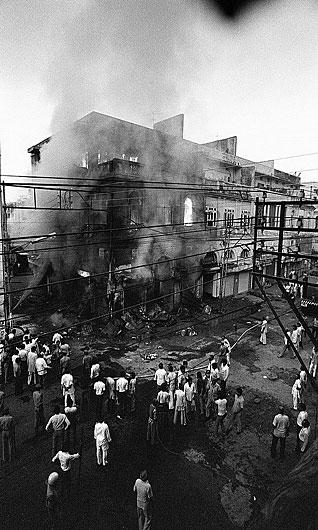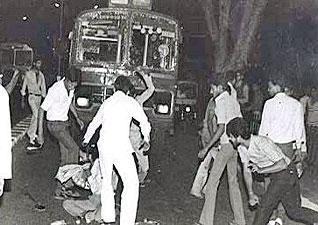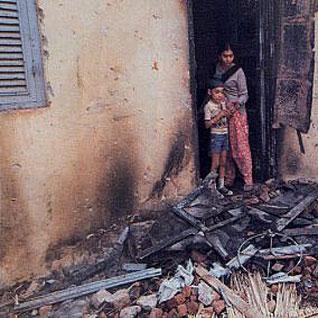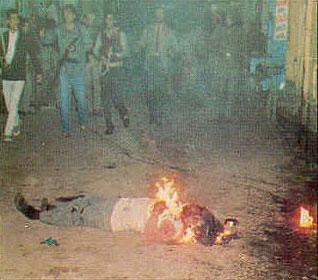
Above, below, homepage & thumbnail - all images depict scenes from the 1984 carnage in Delhi, India.



1984
1984 & I:
An Attack on Jungpura,
The Warriors' Colony
by CHINTAN SINGH
This year, 2009, marks the 25th Anniversary of 1984, when horrendous crimes were committed against the Sikhs in the very land of their origin. To commemorate this sad milestone, we at sikhchic.com have asked our regular columnists, as well as our contributors and readers, to share with us the impact 1984 has had on their lives. We have requested personal stories and anecdotes, as well as an attempt to capture their inner thoughts and deepest ruminations on what 1984 means to each one of them and their loved ones - without going into a litany of facts and figures or a listing of the injustices to date, all of which will invariably be covered with due diligence elsewhere. We intend to present these personal perspectives to you throughout the twelve months of 2009. The following is the 22nd in the series entitled "1984 & I".
I was about eleven years old in 1984.
My family and I then lived in Jungpura (literally, "Warriors' Colony") Extension, originally a colony of partition refugees, in South Delhi, India.
To give you some idea of the area, Jungpura Extension was primarily Sikh populated, with Lajpat Nagar (primarily a Hindu-Punjabi populated colony) at its one side of the border and Bhogal (populated 60:40 by Hindus and Sikhs, respectively) on its other side.
What separated Jungpura and Lajpat Nagar were a few blocks of houses (a total of approximately 100) called Pashauri Mohalla, named after settlers from Peshawar (now in Pakistan), populated primarily by Sikhs involved in the three-wheeler transportation business.
The other side of the Jungpura border was Bhogal, originally occupied by the so-called "Chura" (sweepers) and "Chamar" (cobblers) Hindu communities.
Transporter Sikh businessmen had, over the decades, made money by hard work and business acumen and bought residential land from these original occupants. Although the Hindus were more in numbers in Bhogal, they were hardly visible due to the newly-built double-storey houses by Sikhs over the last few decades.
So, by 1984, Bhogal had had a face-lift with its prosperous Sikh populace. This often invoked jealousy and there were frequent brawls between the Sikhs and the Hindus.
Our house was #2 in the "H" block of Jungpura Extension with house #1 converted into small grocery shops owned mostly by Sindhi Hindus.
Long ago, the owner of House #1 had illegally converted the front portion of the house into shops and sold them at a steep price. My family, being the educated service class, did not quite gel with our shopkeeper neighbours. My parents always wanted to move from that house, since the shops attracted all kinds of customers and there were frequent traffic and parking problems.
We were the only Sikh family in our court and street.
During October-November 1984, I was hosting an American boy named Matthew Kaufmann from a public school in Ohio, U.S.A. He was my age and was staying with us as part of a inter-school cultural exchange program initiated by Guru Harkrishan Public School, Vasant Vihar, which I attended.
Some of our school's students had gone to the United States and stayed with kids in Ohio a few months earlier, and now a group of students from there were visiting us, each staying with a host family.
On October 31, we were all visiting the American Embassy School (an elementary and middle school on the Embassy premises for children of American diplomats) to learn about American children living in Delhi and their school.
While there, we heard around 12 noon that the Prime Minister had been shot and had died.
Immediately, it was decided that we should all head back to our school - Guru Harkrishan Public School. Although we were all only about eleven years old, we knew of the attack on The Golden Temple in a few months ago in June and understood what the assassination of Mrs. Gandhi meant for Sikhs - the victory of good over evil.
We were the first ones to inform our classmates when we got back to school around 1 pm. There was an air of celebration amongst the students.
Of course, little did they know what was in store for them.
The school principal and teachers decided to immediately close the school early that day, as well as declare the next day as a holiday to mark the mourning over the death of the Prime Minister.
We got home around 2 pm that day. My father also came from work a bit early. My grandparents used to live on the first floor of the house and my parents, my siblings and I lived on the second floor.
In the evening, Matthew and I went to a birthday party of a friend. Obviously, everyone was talking about the assassination. However, before long, my father came over to fetch us. I was surprised, since it was still early. He told us that some killings of Sikhs had been reported around the South Extension area and the All India Institute of Medical Sciences (AIIMS), where Indira Gandhi had been brought after the shooting.
My grandmother's brother used to live around AIIMS and he had called to let us know that a big mob was gathering around there.
The night passed by relatively peacefully. Next morning, we woke up to a ghostly-quiet neighborhood and from our terrace we could see umpteen smoke clouds around the city, and could smell smoke and fire. Matthew even quipped that it was the first time he had seen our street so quiet.
My father took the name-plate off the outside of our house. We had heard that Sikh-owned trucks, buses, businesses and properties were being burnt in Bhogal.
We found out later that the Bhogal Sikhs had managed to retaliate against the Hindu thugs in the colony. Probably for that reason, I expect, no deaths of Sikhs were reported from Bhogal.
We were getting calls from the American Embassy asking about our well-being, obviously because Matthew was staying with us. Thus, we witnessed first hand how, truly, Americans look after their own citizens, as goes the lore.
The American Embassy arranged a special flight for all the American exchange children; they were picked up from each host house in Delhi by a diplomatic car on, if I remember correctly, on November 2 or 3.
Late in the day on November 1, the Sikhs of the Pashauri Mohalla started to mobilize and initiated a 24-hour pehra (neighborhood watch) of the entire colony, armed with kirpans and sticks.
The mob tried to enter Jungpura from Lajpat Nagar, but the Pashauri Mohalla defenders met the mob consisting of several truckloads of thugs, and stopped them in their tracks.
Thankfully, the kirpans were enough to scare the hundreds of cowardly hooligans away.
We lived prepared, but constantly in terror, during the next few days.
Each day, my mother would prepare us that if the mob came, we should go on the roof top of our house and from there, climb to our Hindu neighbour's house. Although none of our Hindu neighbours tried to harm us, sadly neither did they volunteer to help us or offer shelter in case the mob ever came.
On November 3, after Indira Gandhi's cremation, curfew was imposed in Jungpura, as well as other parts of Delhi and violence started to subside.
Our Sindhi shopkeeper neighbour, despite the curfew, kept his shop open by operating from our driveway and serving his customers by letting them come inside our driveway to pay him and take the goods, even though we felt very unsafe with it.
I guess, given our vulnerability, he felt he did not need our permission.
From October 31 till November 3, Indira Gandhi's body was kept on public display and shown 24 hours a day on national television and you could hear chants in the background: "Khoon ka badal khoon se" ("Only blood will avenge blood")!
As a mere eleven-year-old, I remained extremely scared for many days following October 31.
I particularly remember that November 3 night after the cremation. P.V.Narasimha Rao, a prominent Congress leader (who, a few years later, also became Prime Minister) made a statement: "Abb kaafi hinsa ho chukki hai" - ("You have had enough of violence now ..."), as his way of asking the mobs to head home.
My father would put on the Shabad, "Jiske sirr uppar toon swami so dukh kaisa paave" ("O Lord, How can any harm come to anyone who You protect") , on the tape-player at night. This is how I learnt this Shabad.
I also remember my parents taught us Chaupai Sahib's first two pauris in those days.
For months, I was scared of the dark and of our parents going anywhere without us. I would worry that they would get caught by a mob, or that a mob would come to the house while they were away.
However, as we all know, there were far worse experiences suffered by many others.
Around November 10, some of the Sikh victims - who were mostly widows and orphans - from Trilokpuri came to the Jungpura Gurdwara and we all went to meet them. I can never forget how everyone broke into sobs and tears when we, the sangat, asked them about what had happened.
This entire sequence of events had a marked impact on us.
My parents, for example - like many other Sikh families - took some immediate measures after November 1984, such as starting to explore opportunities to move abroad or to Punjab. We even bought a plot in Chandigarh to get started. This was a direct result of our fear that more pogroms could happen in the future ... India had ceased to be, in any thinking person's mind, a truly secular or democratic nation, in any true sense of these terms!
Furthermore, my parents also made a choice of limiting their friendships with non-Sikh Indians, since they felt that most of the latter had fallen prey to the government and Hindu fundamentalist propaganda, had lost the ability to face the facts, and could not relate to our perspective or predicament.
A few weeks later, my grandfather and a few other Sikhs, including General Jagjit Singh Aurora - the famous Liberator of Bangla Desh - and the lawyer, Sardar Harvinder Singh Phoolka, Esq., founded an organization called The Sikh Forum to help resettle the victims and also seek justice for them.
For years, these victims - women who were mostly widows, sometimes even small kids, would come to our house. They were blue collar workers or small business owners who were working hard and had aspirations to educate their children and were good citizens; they had lost everything due to no fault of theirs.
If this wouldn't have happened to them, their kids would have been successful men and women today - some would have come to America, like so many of us, and become professionals and executives in big companies or owned businesses.
Also, for years, there was a Police Inspector - a Haryanvi Hindu - who would come to our house to meet my grandfather. The Sikh Forum was fighting his case since he was probably the only Police Officer to our knowledge who had tried to control the mob and had been fired from his job for doing so.
I don't believe he, or any victims, got justice.
The Sikh Forum has long since closed its doors, since most of its founders, including my grandfather, have passed away.
I want to end this piece with an appeal to the worldwide Sikh Community.
We, the survivors, could easily have been the victims of 1984, like our brothers and sisters in Trilokpuri and other such neighborhoods across the country where the pogroms raged through those days. So, I feel that it our responsibility to help resettle the families of those who felt the full brunt of the cowardly thugs who preyed on them on the mere strength of numbers, even if the Indian Government won't lift a finger to their duty.
These Sikhs who died or were brutalized or lost property, did so on our behalf.
I suggest we need to gather the funds necessary to provide the widows and offspring of these victims with scholarships, small business capital funds, housing and shelter so they can once again start to live a dignified life, even though 25 years have passed.
My proposal is that the Sikh Human Development Foundation in Washington, D.C. take up this project, since they already have an infrastructure. If 1000 Sikh families or homes simply contribute US $1000 each in total, we would have 1 Million US Dollars, which is roughly Rs. 45 million.
That may not be enough in view of today's inflation figures, but we could easily help hundreds of families with life-transforming resources, and have a positive impact on thousands more.
I strongly feel that helping the 1984 pogrom victims is even more important than educating the world about Sikhism. If we first don't take care of our own home, there is no point in telling the world how wonderful our home is.
[May 8, 2009]
Conversation about this article
1: Kirtan Kaur (Fremont, California, U.S.A.), May 12, 2009, 3:52 PM.
I agree with you, we should do all we can to help those victim families build themselves up again. Please guide me how and where can I donate.
2: Amardeep (U.S.A.), May 12, 2009, 6:15 PM.
In the documentary, 'The Widow's Colony', S. Patwant Singh said, "We should not ask Indian Government for any help for victims but do it ourselves". For obvious reasons!


